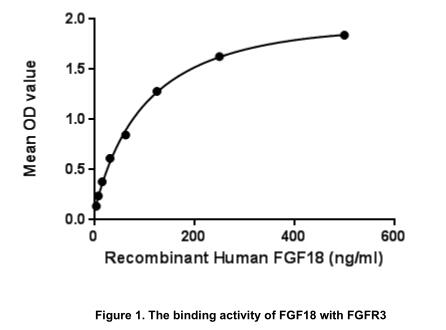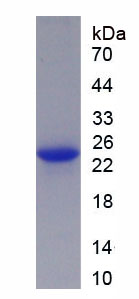Active Fibroblast Growth Factor 18 (FGF18) 

ZFGF5
- UOM
- FOB US$ 314.00 US$ 785.00 US$ 1,570.00 US$ 4,710.00 US$ 11,775.00
- Quantity
Overview
Properties
- Product No.APC907Hu01
- Organism SpeciesHomo sapiens (Human) Same name, Different species.
- ApplicationsCell culture; Activity Assays.
Research use only - DownloadInstruction Manual
- CategoryCytokine
- Buffer Formulation20mM Tris, 150mM NaCl, pH8.0, containing 1mM EDTA, 1mM DTT, 0.01% SKL, 5% Trehalose and Proclin300.
- Traits Freeze-dried powder, Purity > 90%
- Isoelectric Point10.7
Sign into your account
Share a new citation as an author
Upload your experimental result
Review

Contact us
Please fill in the blank.
Activity test

Fibroblast Growth Factor-18 (FGF18) is a trophic factor for mature chondrocytes
and their progenitors. It has been reported to have significant anabolic effects on
cartilage. FGF18 plays a central role in skeletal growth and
development.Besides,Fibroblast Growth Factor Receptor 3 (FGFR3) has been
identified as an interactor of FGF18, thus a binding ELISA assay was conducted
to detect the interaction of recombinant human FGF18 and recombinant human
FGFR3. Briefly, FGF18 were diluted serially in PBS, with 0.01% BSA (pH 7.4).
Duplicate samples of 100μl were then transferred to FGFR3-coated microtiter
wells and incubated for 2h at 37℃. Wells were washed with PBST and incubated
for 1h with anti-FGF18 pAb, then aspirated and washed 3 times. After incubation
with HRP labelled secondary antibody, wells were aspirated and washed 3 times.
With the addition of substrate solution, wells were incubated 15-25 minutes at
37℃. Finally, add 50µl stop solution to the wells and read at 450nm immediately.
The binding activity of FGF18 and FGFR3 was shown in Figure 1, and this effect
was in a dose dependent manner.
Usage
Reconstitute in 20mM Tris, 150mM NaCl (PH8.0) to a concentration of 0.1-1.0 mg/mL. Do not vortex.
Storage
Avoid repeated freeze/thaw cycles. Store at 2-8°C for one month. Aliquot and store at -80°C for 12 months.
Stability
The thermal stability is described by the loss rate. The loss rate was determined by accelerated thermal degradation test, that is, incubate the protein at 37°C for 48h, and no obvious degradation and precipitation were observed. The loss rate is less than 5% within the expiration date under appropriate storage condition.
Increment services
-
 BCA Protein Quantification Kit
BCA Protein Quantification Kit
-
 Molecular Mass Marker for Protein
Molecular Mass Marker for Protein
-
 Monoclonal Antibody Customized Service
Monoclonal Antibody Customized Service
-
 Polyclonal Antibody Customized Service
Polyclonal Antibody Customized Service
-
 Protein Activity Test Experiment Service
Protein Activity Test Experiment Service
-
 Electrophoretic Mobility Shift Assay (EMSA) Experiment Service
Electrophoretic Mobility Shift Assay (EMSA) Experiment Service
-
 Buffer
Buffer
-
 Lentivirus Packaging Experiment Service
Lentivirus Packaging Experiment Service
-
 Adenovirus Packaging Experiment Service
Adenovirus Packaging Experiment Service
-
 Real Time PCR Experimental Service
Real Time PCR Experimental Service
-
 Spike RBD Protein (S-RBD)
Spike RBD Protein (S-RBD)
-
 Protein G
Protein G
-
 Protein A
Protein A
Citations
- Human Umbilical Cord Mesenchymal Stem Cells Over Platelet Rich Fibrin Scaffold for Mandibular Cartilage Defects Regenerative Medicine
- HDAC7 promotes NSCLC proliferation and metastasis via stabilization by deubiquitinase USP10 and activation of β-catenin-FGF18 pathwayPubmed:35277183








